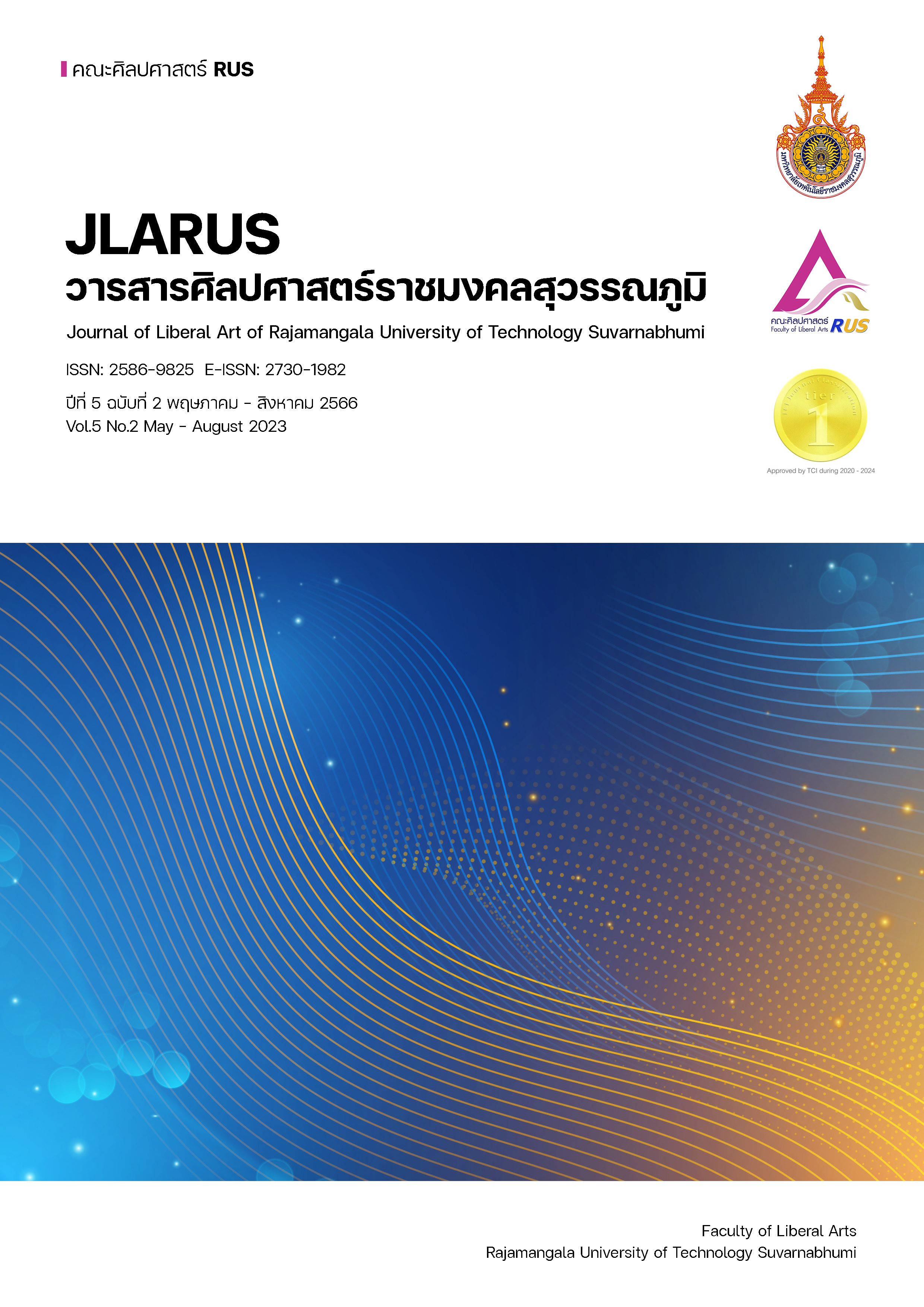MODELOF ART EXPERIENCES MANAGEMENT BASED ONTEACHING FOR ARTISTIC BEHAVIOR AND DESIGN THINKING CONCEPTS TO ENHANCE EXECUTIVE FUNCTION FOR KINDERGARTENERS
Main Article Content
Abstract
This article aimed to develop the model of art experiences management based on teaching artistic behaviors and design thinking concepts to enhance executive function for kindergarteners. This research is a part of research and development. Target group was K3 in school under Office of Private Education Commission. The research was divided into 2 stages: (1) stage of development on model of art experiences management, the informants were 11 experts, who used purposive selection, to check the quality and suitability and (2) stage of trial on model of art experiences management with a sample of kindergarteners, informants were 5 kindergarteners and a teacher. The purposive selection method was used whereas the research tools were: 1) selection form of art objects for kindergarteners; 2) assessment form for content validity of the model of art experiences management; 3) learning experience plan; 4) interview form for teachers' opinions toward the model of art experiences management; 5) report after teaching; and 6) self-monitoring form of kindergarteners. Data analysis was conducted with content analysis method.
The results were found as follows; 1) the model of art experiences management had 3 stages, namely: inspire, share, and do. The quality and suitability analysis results showed that the developed model had a high quality and suitability that passed the specified criteria; (2) The results of the trial using the model found that after using the model of art experiences management, kindergarteners' executive function tends to increase. The developed model of art experiences management can be used to provide learning experiences practically and effectively.
Article Details

This work is licensed under a Creative Commons Attribution-NonCommercial-NoDerivatives 4.0 International License.
References
กมล โพธิเย็น. (2564). Active Learning: การจัดการเรียนรู้ที่ตอบโจทย์การจัดการศึกษาในศตวรรษที่ 21. วารสารศึกษาศาสตร์มหาวิทยาลัยศิลปากร, 19(1), 11-28.
กรมกิจการเด็กและเยาวชน. (2561). กรมสุขภาพจิตมอบของขวัญวันเด็กแห่งชาติ 3 ทักษะสร้าง IQ ดี EQ เด่นให้เด็กไทย. ข่าวสารกรมสุขภาพจิต, 21(242), 1-2.
นวลจันทร์ จุฑาภักดีกุล และคณะ. (2560). การพัฒนาและหาค่าเกณฑ์มาตรฐานเครื่องมือประเมินการคิดเชิงบริหารในเด็ก. ศูนย์วิจัยประสาทวิทยาศาสตร์สถาบันชีววิทยาศาสตร์โมเลกุล, มหาวิทยาลัยมหิดล.
วีระศักดิ์ ชลไชยะ. (2561). พัฒนา EF ตั้งแต่ปฐมวัยรากฐานของการพัฒนาประเทศในยุคThailand 4.0. สื่อสารกุมารแพทย์จุลสารราชวิทยาลัยกุมารแพทย์แห่งประเทศไทยสมาคมกุมารแพทย์แห่งประเทศไทย, 39(1), 11-13.
สำนักงานกองทุนสนับสนุนการสร้างเสริมสุขภาพและสถาบันRLG. (2561). คู่มือพัฒนาทักษะสมองEF Executive Function สำหรับครูปฐมวัย. กรุงเทพมหานคร: มติชน.
สำนักวิชาการและมาตรฐานการศึกษา. (2560). หลักสูตรการศึกษาปฐมวัยพุทธศักราช 2560. กรุงเทพฯ: ชุมชนสหกรณ์การเกษตรแห่งประเทศไทย.
สถาบันแห่งชาติเพื่อพัฒนาเด็กและครอบครัวมหาวิทยาลัยมหิดล. (2563). การประเมินทักษะด้านการคิดเชิงบริหาร (Executive Function) ในเด็กปฐมวัย. นครปฐม: มหาวิทยาลัยมหิดล.
Andersen, P. N., Klausen, M. E. & Skogli, E. W. (2019). Art of Learning – An Art-BasedIntervention Aimed at Improving Children’s Executive Functions. Frontiers in Psychology, 10(1769).
Alexiou, K., Zamenopoulos, T. & Gilbert, S. (2011). Imaging the Designing Brain: A Neurocognitive Exploration of Design Thinking. Design Computing and Cognition, DCC’10. J.S Gero (ed), 487-503.
Center on the Developing Child at Harvard University. (2012). Executive Function (InBrief). Retrieved March 3, 2020, from www.developingchild.harvard.edu.
Center on the Developing Child at Harvard University. (2014). Enhancing and Practicing Executive Function Skills with Children from Infancy to Adolescence. Retrieved March 3,2020, from www.developingchild.harvard.edu.
Center on the Developing Child at Harvard University. (n.d.). Executive Function & Self-Regulation. Retrieved May 11,2021, from https://devhcdc.wpengine.com/science/key-concepts/executive-function/
Dam, R. & Siang, T. (2019). What is Design Thinking and Why Is It So Popular? Retrieved May 11, 2021. from https://www.interaction-design.org/literature/article/what-is-design-thinking-and-why-is-it-so-popular.
Douglas, K. & Jaquith, D. (2017). Engaging Learners Through Art making. USA: Teachers College Press.
Feldman, E. (1996). Philosophy of art education. USA: Prentice-Hall.
Jones, T., L. (2016). Using Self-Monitoring to Increase Self-Regulation in Young Children. (Masters of Arts). Saint Catherine University.
Kenworthy, L., Anthony, G. L., Alexander, C. K., Werner, A. M., Cannon, L. & Green, L. (2014). Solving Executive Function Challenges Simple Ways to Get Kid with Autism Unstuck and on Target. USA: Paul H. Brookes.
Manchanda, N. (2016). How Design Thinking Can Transform Your Child’s Creativity. Retrieved March 2, 2020. from http://medium.com/@NitashsM/how-design-thinking-can-transform-your-child-s-creativity-46700b3ee70c.
McLeod, S. (2019). Bruner - Learning Theory in Education. Retrieved May 5, 2021, from https://www.simplypsychology.org/bruner.html.
Moreno, S., Bialystok, E., Barac, R., Schellenberg, E. G., Cepeda, N. J. & Chau, T. (2011). Short-term music training enhances verbal intelligence and executive function. Psychological science, 22(11), 1425-1433.
Oakley, B., Rogowsky, B. & Sejnowski, J. T. (2021). Uncommon sense teaching: practical insights in brain science to help student learn. USA: Tarcherperigee.
Plattner, H. (2010). An Introduction to Design Thinking Process Guide. Retrieved March 3,2020, from https://www.alnap.org/help-library/an-introduction-to-design-thinking-process-guide.
Prospect Medical Systems. (2020). Mental Flexibility. Retrieved from March 3, 2020, https://www.prospectmedical.com/resources/wellness-center/mental-flexibility.
Riggleman, S. (2017). Self-monitoring: a behavioral intervention for children attending head start. (Doctor of Philosophy - Special Education). University of Nevada.
Sakowski, K. (2019). Whole-brain art education: exploring strategies to increase executive function skills and promote self-regulatory behaviors in elementary art students. (Master of Art Education). Moore College of Art & Design.
TAB. (2019). What is TAB? Retrieved March 3, 2020. from https://teachingforartisticbehavior.org/what-is-tab.html.
Weinberger, E. (2020). Art & Executive Function. Retrieved March 5, 2020, from https://saotg.com/art-executive-function.
Willis, J. (2012). Executive Function, Arts Integration and Joyful Learning. Retrieved March 3,2020, from https://www.edutopia.org/blog/arts-inegration-joyful-learning-judy-willis-md.
Willis, J. (2012). Three Strategies for Using the Arts to Build Student Executive Functions. Retrieved March 3,2020, from https://www.edutopia.org/blog/strategies-executive-functions-arts-judy-willis.
Wright, J. (2013). How To: Teach Students to Change Behaviors Through Self-Monitoring. Retrieved March May 5, 2021. From https://www.interventioncentral.org/sites/default/files/pdfs/pdfs_blog/self_management_self_monitoring.pdf.


